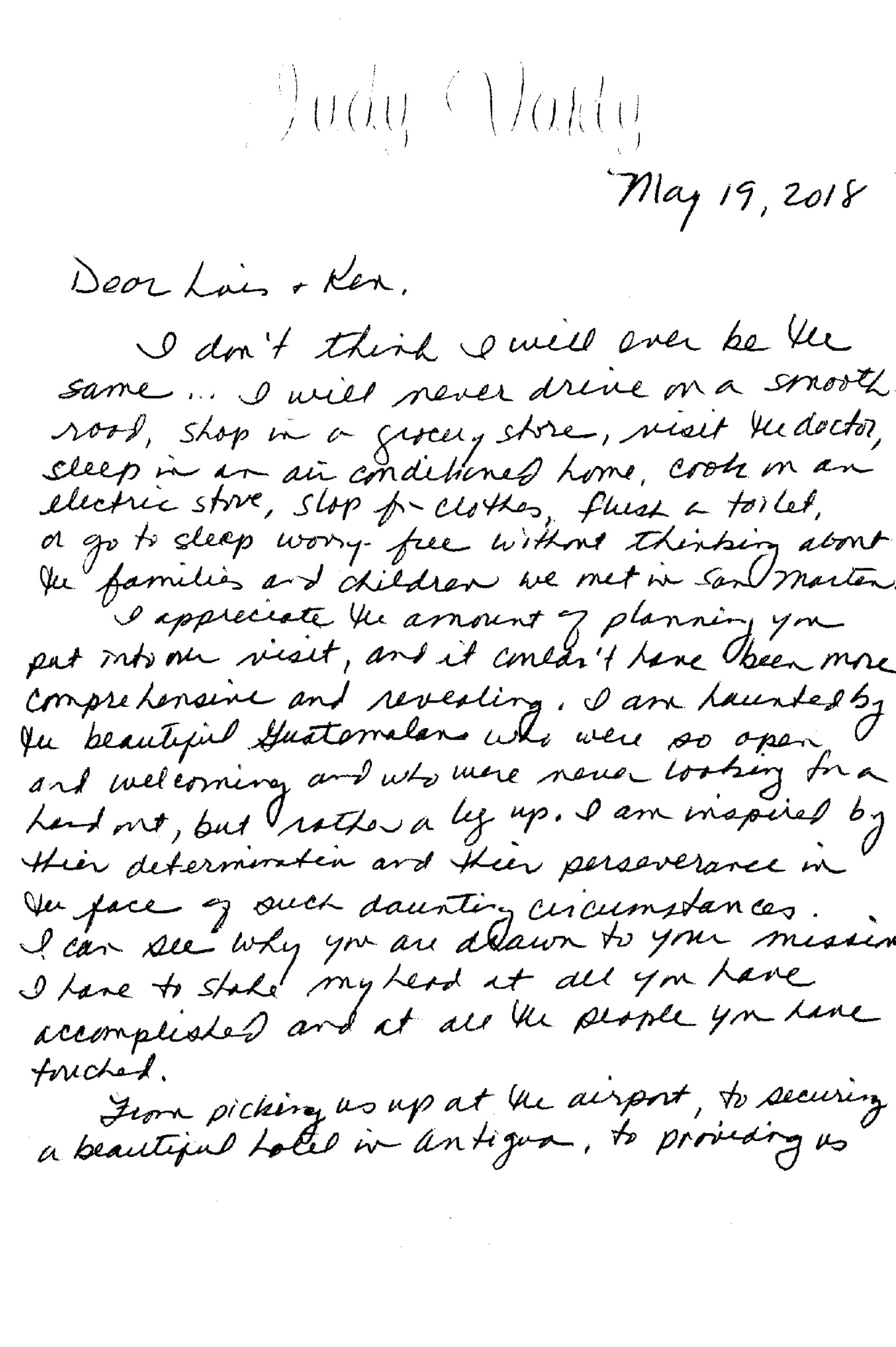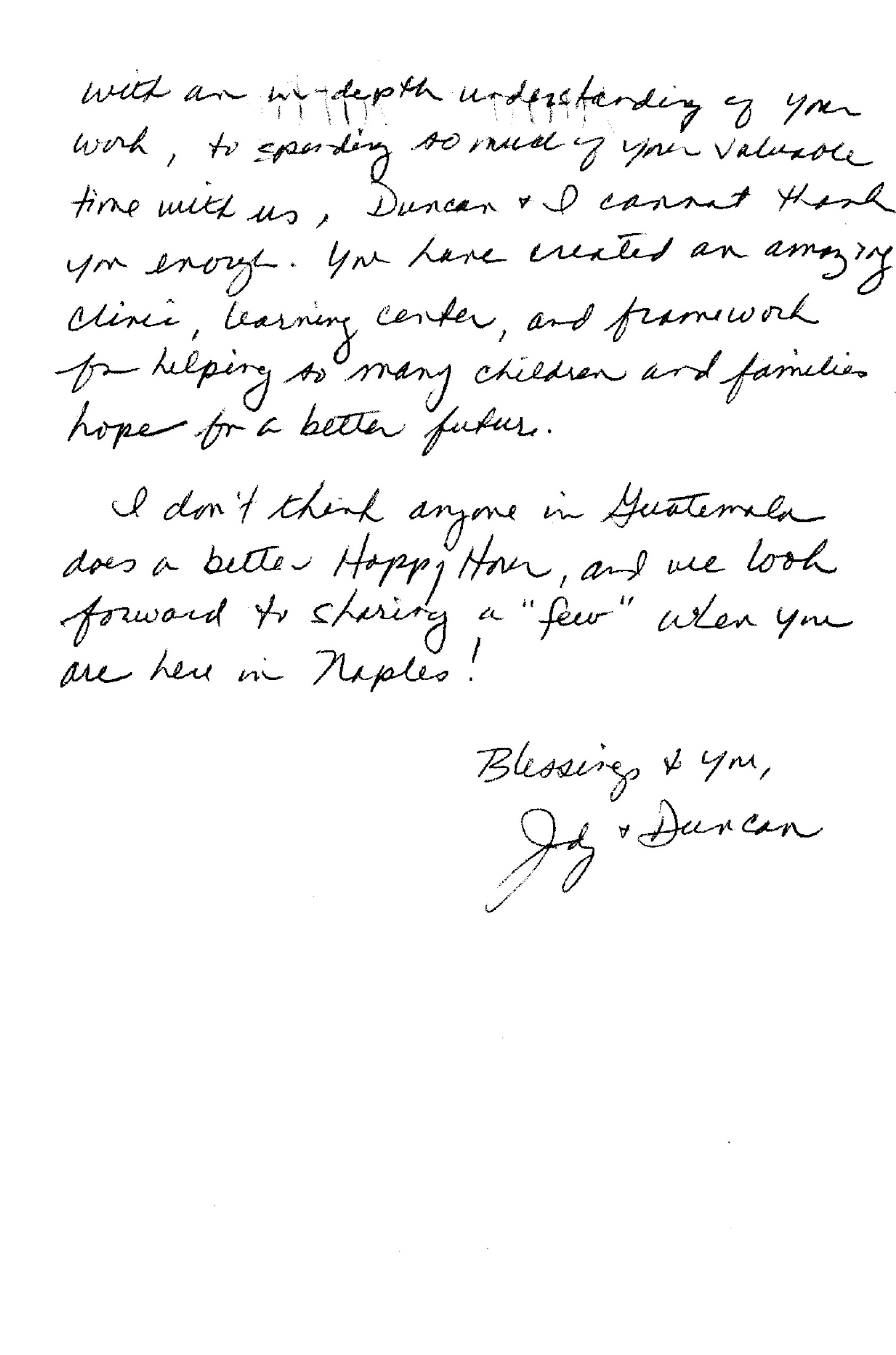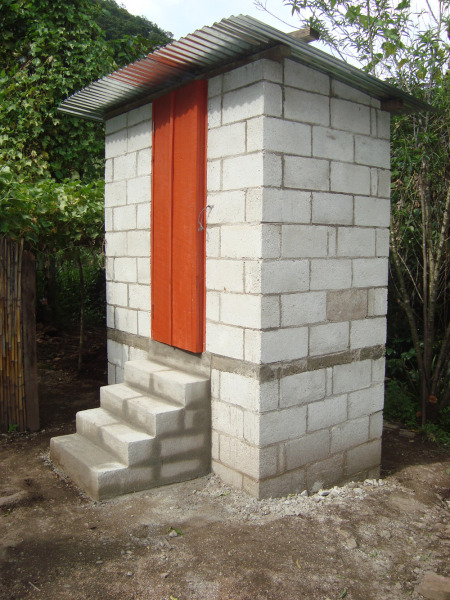- P.O. Box 110221 Naples, FL 34108
- 941-244-8692
- peopleforguatemala@gmail.com

Category Page: Uncategorized
Jose’s Parents Couldn’t Help Him
José Mercedes Ambrosio Saban, now 3 years old, will walk one day
thanks to the support and financial assistance from People for Guatemala, Inc.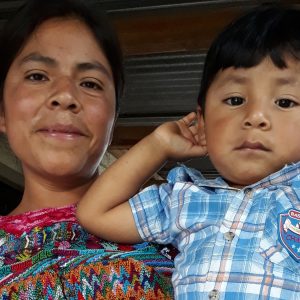
When Jose was born, Rolando Ambrosio and his wife Yohana, realized something wasn’t right with their son’s foot. They became alarmed and immediately sought help at the local government health post. They were told their baby needed to be seen by a specialist at the national hospital in Chimaltenango. During that appointment the doctor recommended x-rays. Rolando only works in agriculture making Q30 to Q50 a day (between $4 and $6.50 a day). With the help of their family, they were able to scrape together enough for the bus fare to take Jose back to the hospital and pay for the x-rays. (more…)
A New Backpack and A New Beginning
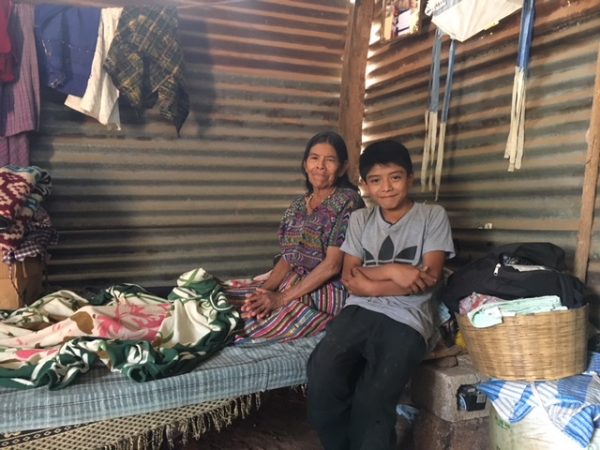
Pedro with his grandmother May 11 2018
Pedro Alvarado, 12 years old, lives in Pacoj Tres Cruces, a remote village in the municipality of San Martin Jilotepeque.
From a very young age Pedro had to go through difficult situations that has deeply affected his life. “My father made a bad decision” said Pedro during his initial interview. “He drank poison and took his life. I was only 3 when he left.”
His mother, shortly after the death of Pedro’s father, abandoned Pedro. Grandma, a widow, became Pedro’s sole caregiver. For his grandmother, caring for and seeing her grandchild grow has been a great blessing. Now 69, Pedro’s grandmother suffers from ailing health. The day we met her she was resting on a bed made only of boards and a blanket.
Grandma has struggled economically all of her life. Pedro, starting from age 7, worked in the fields to earn money to buy food, clothes, and pay for a few school expenses. Pedro has some aunts and uncles but they do not help him or his grandmother.
Starting school in January this year was difficult for Pedro since he did not have money for his school supplies and uniform. As the days went by, Pedro realized the expenses were more than he could earn working in the fields. He decided to reach an agreement with the teachers to pay Q5.00 (60 cents) every week to pay for his uniform and supplies. Upon realizing his situation, one of his teachers, Fredy Tun, decided to look for a scholarship for Pedro because he saw that even though he worked, he was one of the best students with an average of 80%.
In February, we met Pedro and Fredy. Pedro was holding a photo of his grandmother, clearly expressing love for the only one who has cared for him. We listened to Pedro tell his story and express how he wanted so desperately at attend school.
It was a privilege for me to see the joy on Pedro’s face when he learned he would receive a scholarship and be able to fulfill his dreams. I will never forget him because I realize what a life-changing impact I have on children who so desperately want to go to school. He received a new backpack that day – maybe a symbol of a new beginning for him and an example of never giving up.
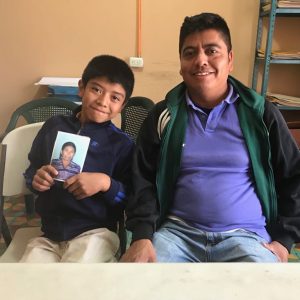
Pedro with his teacher Fredy. Pedro is holding his grandmother’s photo.
Submitted by
Telma Estrada, Psychologist
Manager, Scholarship Program
Beyond the Exam Room
Ventura is 72 years old and lives with his spouse, age 79. They never had children and don’t have family to care for them. His wife, Alma, collects aluminum cans to sell to recycling centers to earn 60 cents per pound. Ventura rises at 4 every morning to travel 5km to feed cattle at a nearby farm. He earns Q30 a day for his work, a paultry $4 a day.
The couple came to our clinic for a medical consultation in February because of a mass growing on the side of Ventura’s neck. He was only taking pain medication but now the pain was stronger. Dr. Garcia attended the patient and diagnosed the possibility of cancer.
Earning only $4 a day leaves the couple desperate for help. “What we have is only enough to buy food” said Ventura. “We have no family to help us.”
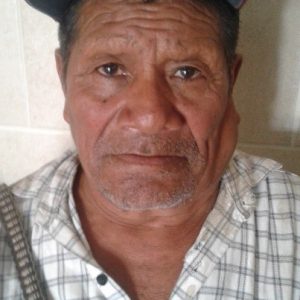
Further testing is necessary to determine the exact diagnosis and treatment plan. Since Ventura and Alma never had the opportunity to go to school, neither can read nor write. Maneuvering through the maze of paperwork at a strange hospital is a task that is impossible for the elderly couple.
Our work goes beyond the exam room. Patients receive assistance making appointments with specialists in Guatemala City, cost of diagnostic tests, medicine, and transportation. Many times patients are ill and cannot ride a public transportation bus. We help patients and their families by transporting them to the appointments and follow up with test results.
Investing in our work in rural Guatemala means saving lives and changing lives. People suffer because they do not have the resources to see a doctor. Our Guatemala health time sees upwards of 775 patients a month, most with diseases and ailments that have gone undiagnosed and untreated. Your support enables us to provide quality medical care for some of the poorest people on earth.
To Another Person in the World
To Another Person in the World, With Hopes and Dreams,
I want to share this gift I received from the church at Christmas. I’m the janitor, the person who helps keep the church clean.
This year I had thought of buying something for myself. Oil painting supplies, or I was going to give it to one of my daughters who is unemployed, but God will provide in another way. I thought about buying extra food, something special for the holidays but that would be forgotten.
So I decided on giving this to you. A person I don’t know, but a person who is going through life just like myself with concerns, and love for others. Enjoy this gift. Praise to Our Creator God, who put this all together to bless us both.
Michael, our Pastor allows us to express what we believe, as individuals, to question why we believe what we believe. As we worship, or gather as a community, we acknowledge that we are all in the River of God, just at different places along the way of life.
So enjoy your new stove. I will think of you daily when I use my stove at home.
Blessing upon you and all of those you love and meet in life.
Bill
Bill Gray is an Artist in Kansas City, Missouri and works at the Southwood United Church of Christ, Raywood, Missouri
A safe, sanitary place to GO!
Hundreds of families in rural Guatemala do not have bathrooms or running water. Many are forced to deficate in nearby corn fields. This creates several health and hygiene problems. Some families have pit latrines which is a deep hole in the ground with a seat over the hole surrounded by whatever material they can use to provide a little privacy. Many times these pit latrines fill with water during the rainy season and collapse.
A pit latrine needs to be installed 45 feet from any water source. Most families do not have enough land to comply with this requirement. Another problem with pit latrines is flies and bad odor.
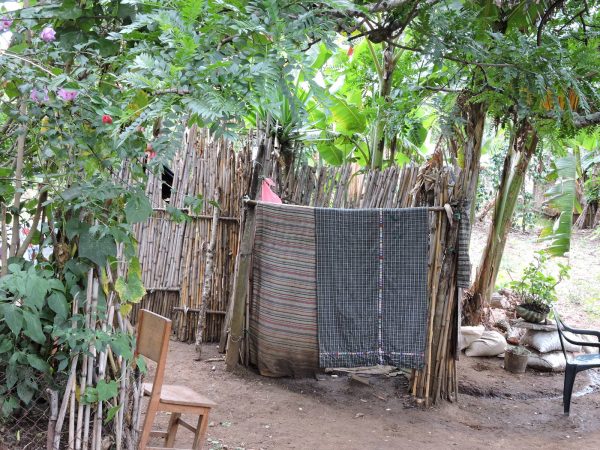
Pictured above: A family’s bathroom
A composting latrine solves many problems. It not only protects a community’s water supply but also provides them with a rich, organic fertilizer to boost food harvests. An added benefit is it provide a safe, secure, and private place to ‘go’.
ADVANTAGES OF THE DRY COMPOSTING TOILET SYSTEM
- It does not use water.
- It is not costly to construct or to use.
- It does not occupy much space.
- It can be installed inside or outside.
- Can be built close to the house
- With good handling, it doesn’t produce disagreeable odors.
- It produces an organic fertilizer that has a minimal probability of pathogenic organisms (organisms that produce illnesses).
- It produces a constant supply of liquid fertilizer. Urine + Water + Time = Urea
The cost to build a composting latrine is about $700. Providing a family with a composting latrines requires education and follow up to be sure the family uses the latrine correctly. There are steps to follow after each use to create dry, fertile compost. There are two compartments. After approximately 6 months (depending on the size of family) the first compartment is closed and the seat moved to the second compartment. After another 6 months the compost is ready to use.
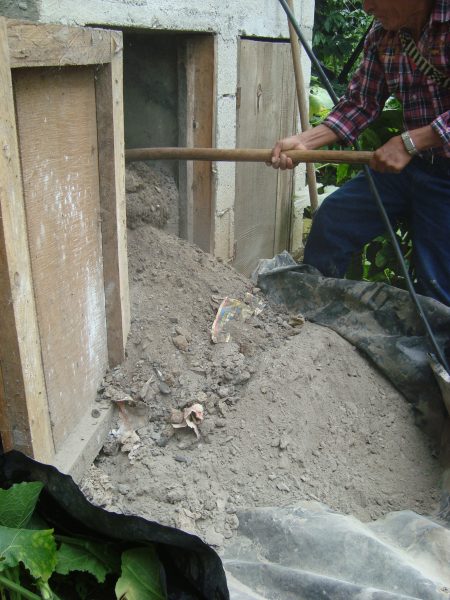
Above, Juan Carlos sees the compost after six months. The compost is fine, dry, and easy to apply on crops.

